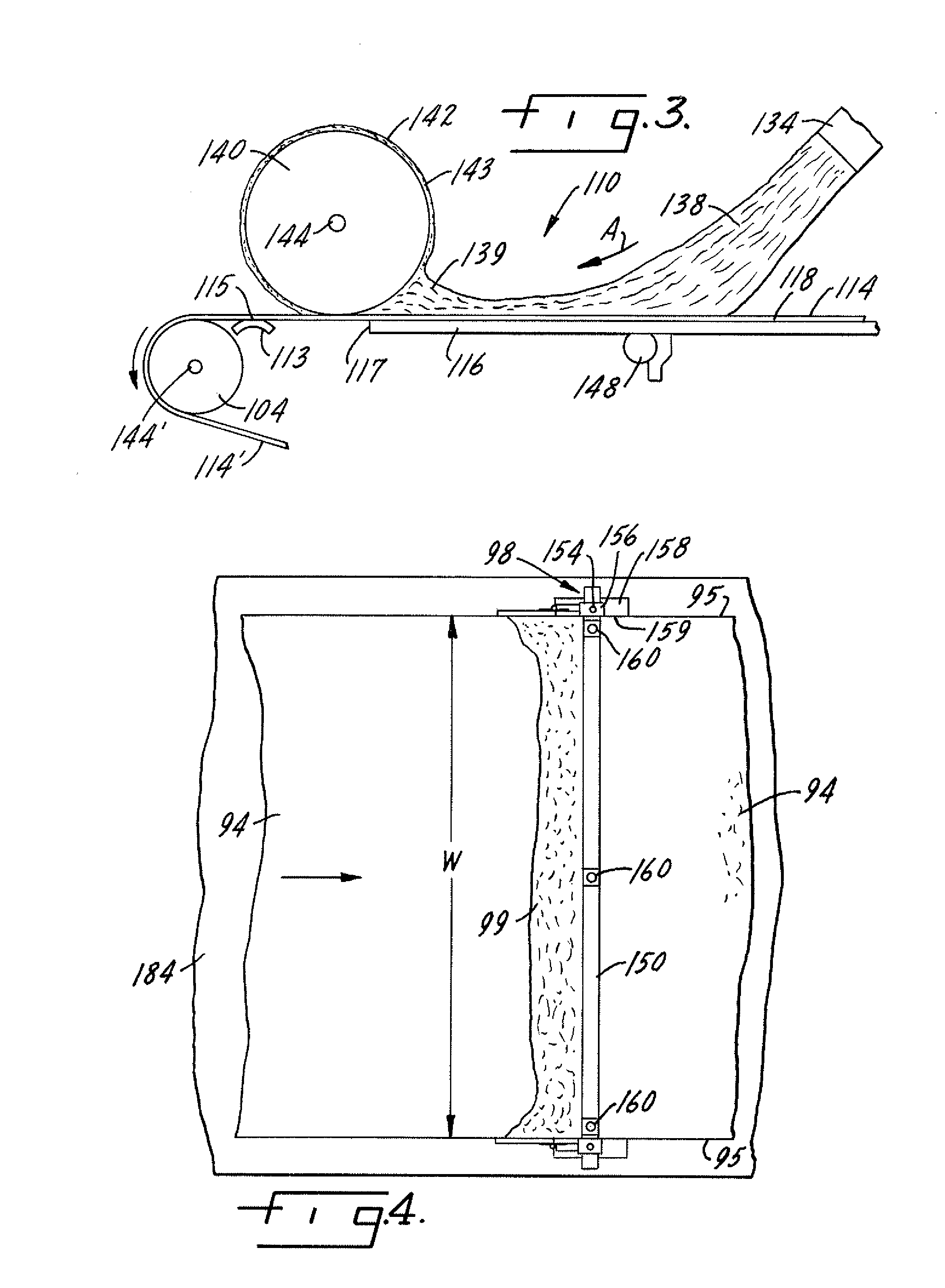This is a particular problem at the edge margins of the board where the bottom mat is brought up and onto the upper surface of the board to define the edges of the uncut board.
Inefficient exhaustion of air in this region can lead to voids in the edge margins of the
cut boards, reducing the
edge strength of the boards.
The problem of voids in the edge margins has been dealt with by increasing the
fiber diameter of the mat, particularly the bottom mat (to, for example, 16 μm (0.0065 inch)), allowing easier exhaustion of air and penetration of gypsum
slurry, but which consequently may result in a reduction of board strength.
Additional compromises in optimization between concerns of cost and of effectiveness arise from the amount of penetration of
slurry through the glass mat fibers.
It has been found that when gypsum boards with exposed glass fibers, such as those taught, for example in U.S. Pat. Nos. 4,647,496; 4,810,659; 5,371,989; 5,148,645; 5,319,900; and 5,704,179, are handled at a construction site by workers, exposed glass fibers penetrate the
skin of uncovered hands, and this generally results in worker discomfort.
Manufacturing facilities for the production of gypsum board, whether or not glass mats are utilized for the structural facings, are capital intensive in the costs of space, equipment and in the down time during which a gypsum board
production line is reconfigured.
For production of a variety of gypsum board products, for example, standard paper faced gypsum board, glass mat backed board, etc., down time of the
production line represents a significant cost in the
delay of production of gypsum board and in time wasted by production workers who remain idle.
To perform the complete process takes a predetermined amount of time, which is an uncompromising restraint on the amount of gypsum board that can be processed on a gypsum board line.
Additional compromises in optimization between concerns of cost and effectiveness arise from the amount of penetration of
slurry through the mineral or glass mat fibers when these are utilized as facing materials.
It has been found that when gypsum boards with exposed glass fibers, such as those taught, for example, in U.S. Pat. Nos. 4,647,496; 4,810,569; 5,371,989; 5,148,645, 5,319,900; and 5,704,179, are handled at a construction site by workers; glass fibers penetrate the
skin of uncovered hands and result in discomfort.
Although the
smooth surface of gypsum boards provided by the process utilized in aforementioned U.S. Pat. No. 4,378,405 is adequate to achieve the stated purposes, the process of manufacture, and especially the vibration steps, tend to slow down board production operation and to render the process useful only for specialized applications for which a customer is willing and able to contend with delays in production and in the consequential costs.
Moreover, it is not possible to utilize the process of making GRG gypsum boards as taught by U.S. Pat. No. 4,378,405 in a standard gypsum board line because that process requires structural changes to the board
production line, which may take time and capital to effectuate.
However, it is known that products made in accordance with these patents are also subject to
delamination or peeling of the coatings and that the
fiber mat is expensive and hard to manipulate when it is pre-coated.
A number of other issues can also arise, including the
surface tension inhibiting the adhesion of other finishing materials, such as
Portland cement, onto the surface of the board, or that the amount of coating that is necessary to achieve an acceptable level of performance exceeds the profitability margins for these types of products.
In such a case, the
moisture in the
adhesive would move from the
adhesive into the substrate in a short amount of time, thereby not allowing the hydraulic
cement to fully cure.
The barriers not only prevent direct
water damage to building materials by seepage, but also help to control the growth of mold and
mildew that may thrive in a moist environment, and which can be detrimental to the health of occupants.
More recent
building code changes have mandated that phasing out of green board, as it has been recognized that water can wick up paper surfaces even if they have been treated and thereby cause damage to the backing wall board on which tiles are adhered.
Once the backing integrity is compromised, the tiles become loose and cause the seal to the wall to be broken, thereby allowing more water ingress and continuing the damage to the wall in an ever accelerating vicious circle that ultimately requires removal and replacement of the complete wallboard behind the tile surfaces.
The glass reinforced gypsum boards made in accordance with the teachings of aforementioned U.S. Pat. No. 6,524,679 are utilizable for wet area applications, but nevertheless are not ideally suited therefor because once installed, the gypsum boards do not provide a complete shield and / or an optimal permeability to
water vapor so as to permit any accumulated water to be repelled from surface and stop
moisture from entering within the walls.
 Login to View More
Login to View More 


